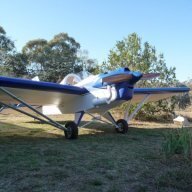The problem of a cheap engine for ultralights has been around since these planes first started to appear. It was the cost (and weight!) of imported Lycoming & Continental engines that put off any but those with a large private income from building their own light planes.
I built my first ultralight - a Pterodactyl - in 1978. The engine used as standard was a 350cc Sachs 2 stroke. It was light, nominally 25hp, but a bit of thumper as a single piston. The prop used was 36" dia, bolted directly to the crankshaft. The noise it made at high revs was deafening, due to the prop tips approaching supersonic speed. This setup didn't produce much thrust, so after I'd learned to fly the Dactyl (by trial & error, no schools or licences in those days) I set out to improve the thrust from the standard engine.
I built a test rig using a spring scale to measure static thrust, which came to 70lb. I then built various reduction drives, using vee belts and toothed belts (I never used chain drive, because the combination of reduction ratio & power I needed exceeded Reynold's published figures). I played around with ratios, and made several different props. The setup I finished with produced 180lbs static thrust, using a 54" prop. (I subsequently bolted on a Robin 50hp engine, which with a 58" prop gave 280lbs.)
After I'd put a few hours on this gear, I was approached by other Dactyl pilots, so made systems for them.
Now, this is where what appears to be a fairly simple mechanical problem - that of building a reliable, light weight, & low cost reduction drive, begins to reveal its problems.
I started getting failures, necessitating deadstick landings in remote paddocks. One of my customers was cruising at 2500' when his engine suddenly overspeeded. The entire reduction gear had detached, and subsequently went through the tiled roof of a house. I got a call from CAA (UK CASA), about 2 weeks later, that I'd rather not think about.
The problem is fatigue. The Dactyl engine mount was very light & whammy, as was the entire airframe. The single cylinder 350cc engine was very lumpy. The airflow onto the pusher prop was far from clean, leading to asymmetric airflow into the prop. At certain revs, vibrations started to trigger harmonics somewhere in the system. This is always going to be an issue in a light structure with an engine producing any reasonable power, as the tail tends to wag the dog.
Anyway, in the end I did get a system to work, at least for 120 hours before my beloved, & much modified, Dactyl died of other causes.
The moral of the story is this. Yes, there are lots of small engines around that can be bought cheaply. Yes, at first glance, a reduction drive looks simple. But unless you have access to precision casting, milling & turning, and some pretty solid engineering nouse, it is much harder to make a simple, light, robust & fatigue proof reduction gear than you'd think. That's why the only retrofit bolt on redrives I know of that are sold are gearboxes, and they're not cheap. Nor would it be cheap to pay for the engineering needed to produce your own design. And incidentally, I have spent nearly all my working life as a mechanical engineer, and about half of that working with aircraft.
Please don't write me off as someone who is saying 'it can't be done'. I know it can, because I've done it, at least with some degree of success. I'm just saying it's a lot harder than it looks, so if you go down that road, be prepared for a long & winding one.
You might do better to look at direct drive, using a 4 stroke industrial motor (Briggs & Stratton & Honda, as well as numerous Chinese copies of these, exist in various power outputs. Motorbike engines too, might work). The downside will be the weight will approach what you hoped the thrust would be, and the thrust will be what you hoped the weight would be.
Bruce












